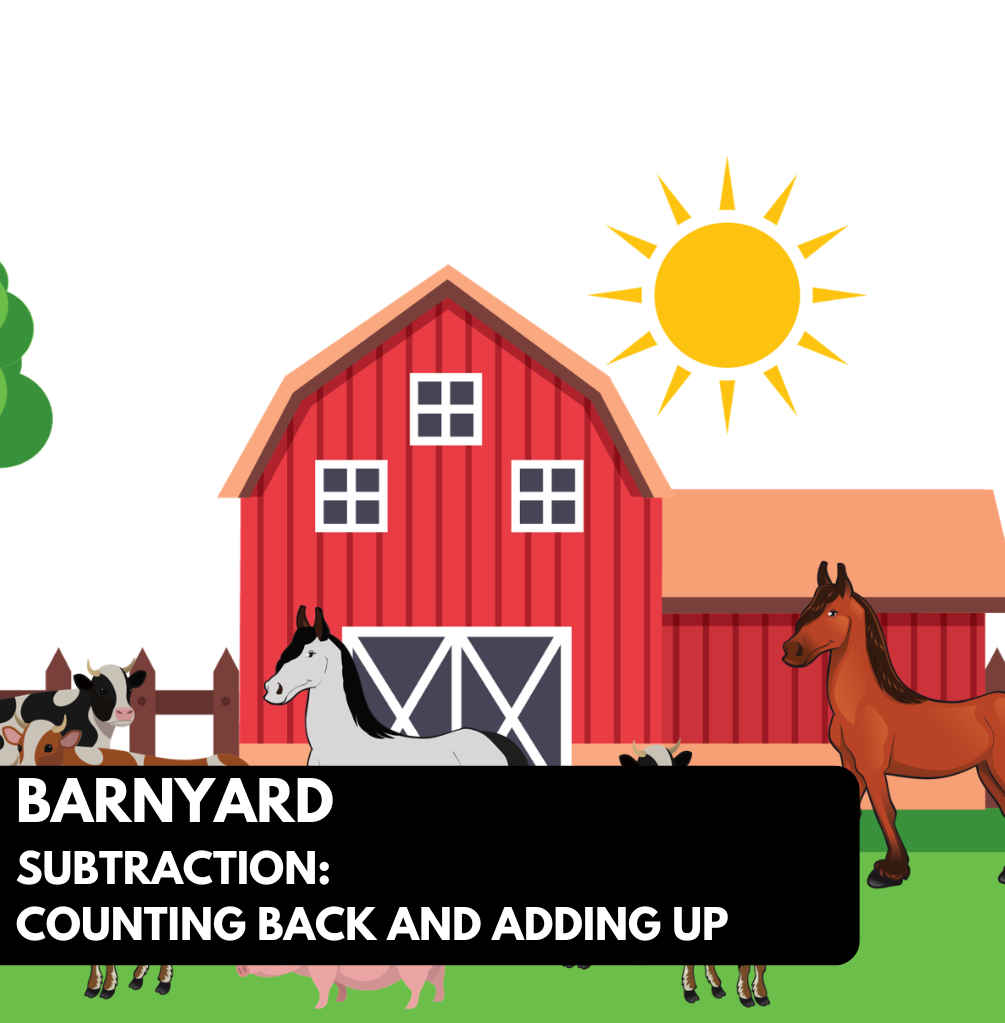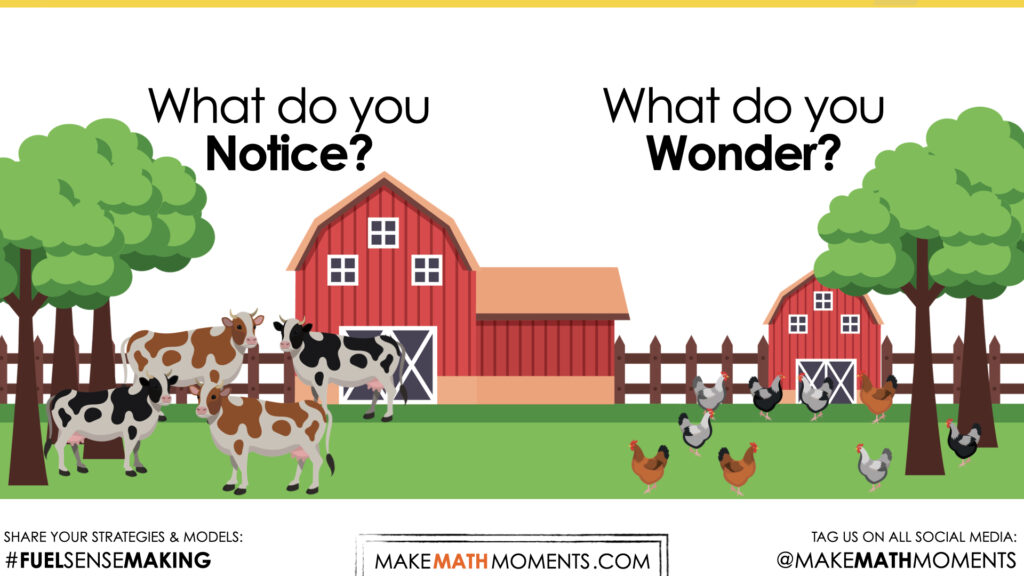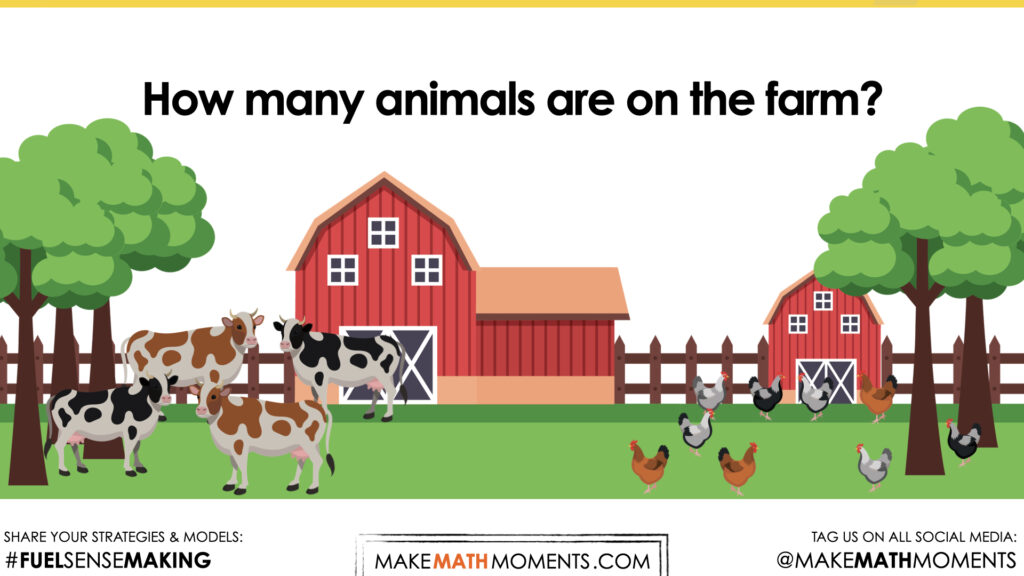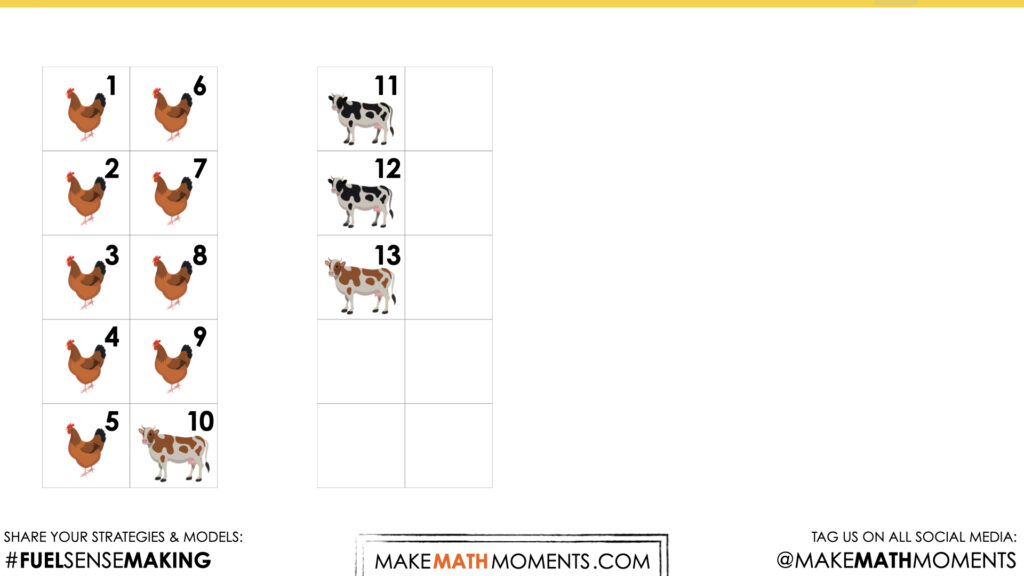BARNYARD [DAY 3]
Subtraction: Counting Back and Adding Up
Investigate early subtraction strategies through counting back and adding up to find the difference.
Intentionality
Spark Curiosity
Fuel Sensemaking
During Moves
Student Approaches
Next Moves
Consolidation
Reflect and Consolidation Prompts
Resources & Downloads
Educator Discussion Area
Intentionality & Unit Overview

Length of Unit: 5 Days
Access each lesson from this unit using the navigation links below
Students will explore the concept of adding up to find the difference when solving a subtraction problem.
In this task, students will continue exploring subtraction using a new strategy of finding the difference between numbers by adding up. On Day 1, students investigated the take away meaning of subtraction. In this Day 3 task, students will explore another meaning of subtraction: comparison. Today, students will be exposed to a new situation called Compare Difference Unknown. This context helps students see that the unknown number is how far apart the two numbers are or what needs to be added to get to the total.
Some of the big ideas that may emerge in today’s lesson include:
- Subtraction names the missing part in terms of the whole
- Counting back is efficient when the count back is small
- Adding up to find the difference is efficient with the subtrahend is close in value to the minuend
- Addition and subtraction are related in that addition names the parts in the whole and subtraction uses the whole to find a missing part.
- Subtraction can be used in either take away, comparison, or missing addend situations.
Spark Curiosity
What Do You Notice? What Do You Wonder?
Show students the following video and share the following prompt:
Then, ask students:
What do you notice?
What do you wonder?
Give students 60 seconds (or more) to do a rapid write on a piece of paper.
Then, ask students to share with their neighbours for another 60 seconds.
Finally, allow students to share with the entire group.
Some of the noticing and wondering that came up in a class recently included:
- I notice chickens.
- I notice cows
- I notice there are 13 animals
- I notice there are more chickens than cows
- I wonder where the other animals are?
- I wonder if there are more animals in the barn.
Estimation: Prompt
Share the following image and verbally prompt the following to your group:
How many animals are on the farm?
Make an estimate.
While Students Are Estimating…
Monitor student thinking by circulating around the room and listening to the conversations that students are having about the amount of animals that are on the screen.
While students are updating their estimate, listen and observe as students work to make updates. What strategies and mathematical models are students leveraging? Are they:
- Counting by ones?
- Skip counting?
Allow students to share and justify their estimates with a neighbour first, then with the class. Write down their estimates on the chalkboard/whiteboard/chart paper so students feel their voices are being heard and so they feel they have a stake in solving this problem.
Estimation Reveal
Share the following short animation to reveal the estimate and nudge us towards the struggle prompt for today’s lesson:
Fuel Sense-making
Crafting A Productive Struggle: Prompt
Login/Join to access the entire Teacher Guide, downloadable slide decks and printable handouts for this lesson and all problem based units.
During Moves
While Students Are Productively Struggling…
Login/Join to access the entire Teacher Guide, downloadable slide decks and printable handouts for this lesson and all problem based units.
Student Approaches
Student Approach #1: Direct Modelling and Counting all
Login/Join to access the entire Teacher Guide, downloadable slide decks and printable handouts for this lesson and all problem based units.
Student Approach #2: Add Up (Using a Number line to model)
Login/Join to access the entire Teacher Guide, downloadable slide decks and printable handouts for this lesson and all problem based units.
Student Approach #3: Known Addition Fact
Login/Join to access the entire Teacher Guide, downloadable slide decks and printable handouts for this lesson and all problem based units.
Next Moves
Reveal
Login/Join to access the entire Teacher Guide, downloadable slide decks and printable handouts for this lesson and all problem based units.
Consolidation
Login/Join to access the entire Teacher Guide, downloadable slide decks and printable handouts for this lesson and all problem based units.
Reflect and Consolidation Prompts
Provide students an opportunity to reflect on their learning by offering these consolidation prompts to be completed independently.
Consolidation Prompt #1:
Login/Join to access the entire Teacher Guide, downloadable slide decks and printable handouts for this lesson and all problem based units.
Consolidation Prompt #2:
Login/Join to access the entire Teacher Guide, downloadable slide decks and printable handouts for this lesson and all problem based units.
We suggest collecting this reflection as an additional opportunity to engage in the formative assessment process to inform next steps for individual students as well as how the whole class will proceed.
Resources & Downloads
Login/Join to access the entire Teacher Guide, downloadable slide decks and printable handouts for this lesson and all problem based units.
Educator Discussion Area
Login/Join to access the entire Teacher Guide, downloadable slide decks and printable handouts for this lesson and all problem based units.
Explore Our 60+ Problem Based Units
This Make Math Moments Lesson was designed to spark curiosity for a multi-day unit of study with built in purposeful practice, number talks and extensions to elicit and emerge strategies and mathematical models.
Dig into our other units of study and view by concept continuum, grade or topic!





